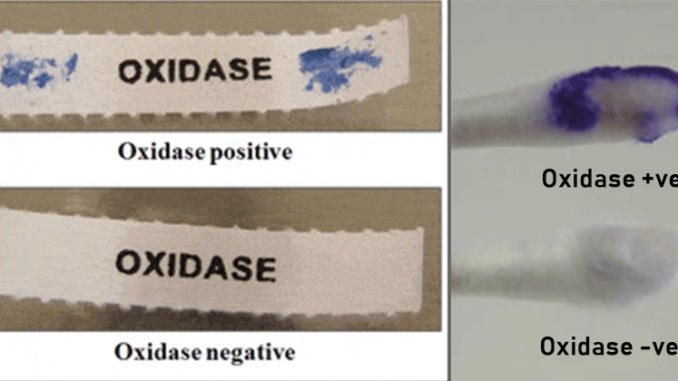
Oxidase test
Objective:
- to check for presence of terminal enzyme Cytochrome C oxidase or Cytochrome a3.
Principle of oxidase test:
Oxidase is a terminal enzyme in aerobic respiration. The aerobic respiration mechanism is composed of a number of enzymes which alternatively oxidize and reduce each other by donating or accepting electrons derived from H2. Hydrogen atoms are removed from various substrates during oxidation reaction and ultimately H2 atoms are combined with O2to from H2O.Thus, cytochrome C oxidase is the terminal electron acceptor in this electron transport chain (ETC) reaction and it’s function is to transfer electron from H2 to O2 to from H2O molecule. This is the classic aerobic respiration scheme that most organisms utilize to derive energy from food they take in as molecule of ATP.
The presence of Cytochrome C oxidase in the organism is determined by the reagent tetremethyl-p-phenylene diamine dihydrochloride. This reagent serves as artificial substrate donating electron and thereby becoming oxidized to a blakish compound in presence of enzyme oxidase and free O2. Development of pink, then maroon and finally black coloration after rubbing the organism in filter paper soaked with the reagent indicates the positive test.
Application: Oxidase test is used for identification of Pseudomonas spp, Aeromonas spp, Neisserias spp, Vibrio spp and Pasteurella spp, all of which produces Oxidase enzyme from Member of enterobacteriaceae give negative oxidase test.
Requirements:
- 24 hours Culture of E.coli and Pseudomonas spp
- Filter paper soaked with 1% tetra methyl-p-Phenylenediamine dihydrochloride
- Glass rod
Procedure of Oxidase test:
- Place a piece of filter paper in a clean petridish and add 2-3 drops of freshly prepared oxidase reagent (1% tetra methyl-p-Phenylenediamine dihydrochloride)
- Place a small portion of culture on the filter paper with the help of a sterile glass rod and make a smear on it.
- Examine for immediate color change to blue purple within 10 seconds.
*note: this test can also be performed by flooding the culture plate with oxidase reagent but it is not recommended because the reagent rapidly kills the bacteria.
Result interpretation:

Pseudomonas spp: blue-purple color; Oxidase Positive
E. coli: blue- no purple color; Oxidase Negative
Precautions:
- Do not use wire loop to transfer the culture as oxidase reagent may reacts with iron or nichrome to give false result
- Observe the result within 10 seconds as Atmospheric Oxygen may react with reagent to give false positive result.
- Culture should not be more than 24 hours old
Reference:
- Manandhar S, Sharma S (2006), “ practical approach to Microbiology”
- Cheesbrough M (1989), “medical laboratory manual for tropical countries”
